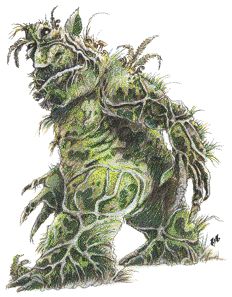Like other breeds of dangerous plants, these are not at all defenseless. Some are the unnatural results of arcane influences, while others may have evolved naturally.
Shambling Mound
Shambling mounds, or shamblers, appear to be heaps of rotting vegetation. They are actually an intelligent form of plant life, with a roughly humanoid shape, and a brain-like control center in its “chest” area. A shambler has a 6-foot girth on its lower half, tapering to about 2 feet at its “head”.
Shambling mounds are found only in regions of dense rainfall and vegetation. Dismal swamps, marshes, and rain forests are their favorite living areas, but some wet, subterranean places also serve as shambler lairs.
They are solitary beasts, rarely living in the same area with other shamblers – usually only in areas where the food source is constant, near famous ruins, or abandoned gold mines.
Shamblers are almost totally silent and invisible in their natural surroundings; opponents suffer a -3 penalty to surprise rolls. A shambler often lies in a shallow bog, waiting for some creature to walk onto it, then it attacks. The creatures are excellent swimmers as well, and they have been known to sneak into the camps of unsuspecting travelers at night.
A shambling mound attacks with huge, arm-like appendages; a victim hit by both arms in the same round is entangled in the creature’s slimy vines and rotting vegetable matter. Entangled creatures suffocate in the slime in 2d4 rounds unless the shambler is killed, or the victim breaks free with a successful bend bars/lift gates roll.
Because of the vegetation which covers its critical inner body, the shambling mound is immune to blunt weapons, and takes only half damage from piercing and slashing weapons. The creature is immune to fire, and takes half or no damage from cold, depending on whether it makes its saving throw. Lightning actually causes a shambler to grow, adding 1-foot to its height, as well as 1 HD and appropriate hit points, for each lightning-based attack used against it.
Because of the location of its brain, the shambler cannot be killed by lopping off its head or limbs. The remaining vines along the torso join together to form a new extremity within one round. Only when enough of the shambling mound has been hacked away, will it finally die. A wounded shambler need only rest in a damp clump of foliage to heal; it rises again in 12 hours, fully healed, and probably angry.
Since shamblers gain power from electrical attacks, there are rumors of shambling mounds with 20 or more Hit Dice. Since they often live in the same areas as will-o’-wisps, there may be truth to such rumors, and giant shamblers may inhabit deep, dark swamps and jungles.
Strangleweed
Strangleweed is an intelligent kelp found in relatively warm sea water. A bed of these carnivorous plants are indistinguishable from normal seaweed. A strangleweed patch will cover an oval area of 3d4 square feet, on the sea’s surface; 3d4 fronds of varying lengths (1d6+6 feet) hanging downward from the patch.
Any creature near enough is attacked, a hit indicating that the frond has entwined about its victim. Any victim entwined suffers a -2 penalty to attack rolls. Each frond has 4d4 Strength points, and the other fronds add their Strength to the total. A victim compares Strength with the strangleweed; Strengths of 18/51 to 18/00 are rounded up to 19. If the victim is stronger, each point of difference in Strength gives a 10% chance of escape, which can be attempted each round.
If the frond is stronger than the victim, the victim cannot escape alone, and the fronds crush the victim for 1 point of damage, per point of Strength difference. If the two are of equal Strength, the victim cannot escape, but takes no damage.
Giant Sundew
A giant sundew appears to be a 3- to 4 foot-mound of grayish green, tarry ropes or rags. The air around one is fly infested and holds a thick odor like sweet syrup. Preferring shaded places in which to grow, the sundew has only hair-like roots that anchor it lightly in place. It can pull itself slowly along the ground using sticky tendrils. Due to the plant’s sticky exterior, missiles and fire-based attacks inflict only half damage.
The sundew detects moving creatures by vibrations. When anything moves within 5 feet of it, it lashes out with its tendrils. Its body is covered with hundreds of tendrils, and a maximum of six can attack each creature in range, each round. The tendrils exude sticky globs of sap. For every three tendrils that attach to a victim, the victim suffers a -1 penalty to attack rolls. The sap contains a mild enzyme that inflicts 1 point of damage per round for each tendril striking the victim, regardless of whether or not the tendril is still attached. A successful open doors roll breaks a tendril; each tendril must be checked separately, up to once per tendril, per round.
If a sundew’s attack roll is an unmodified 20, it has struck the victim’s mouth and nose, clogging them with sap; suffocation occurs in 1d3+1 rounds unless the sap is removed. The sap may be dissolved by vinegar or alcohol.
Thorny
Thornies are dog-like plant creatures trained as guards by mold men. They are covered by a spiky bark. A thorny attacks first with its bite; if the bite hits, the creature tries to roll its body against its victim, causing 3d4 points of damage with a successful hit. Thornies reproduce by laying egg-like seeds in the ground. A small tree sprouts from the seed, eventually producing buds which grow into small thornies. Thornies can be trained if raised from buds.

